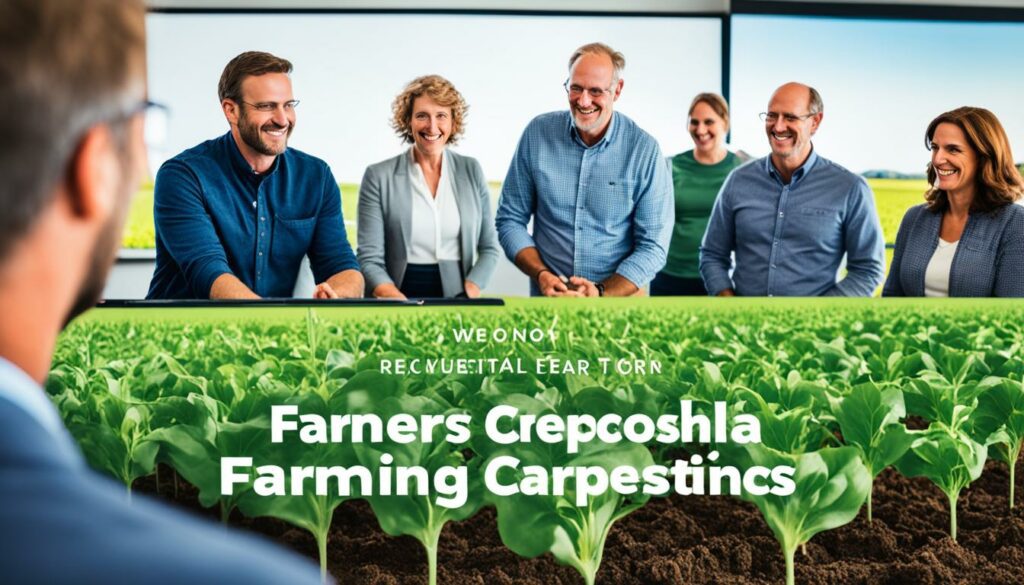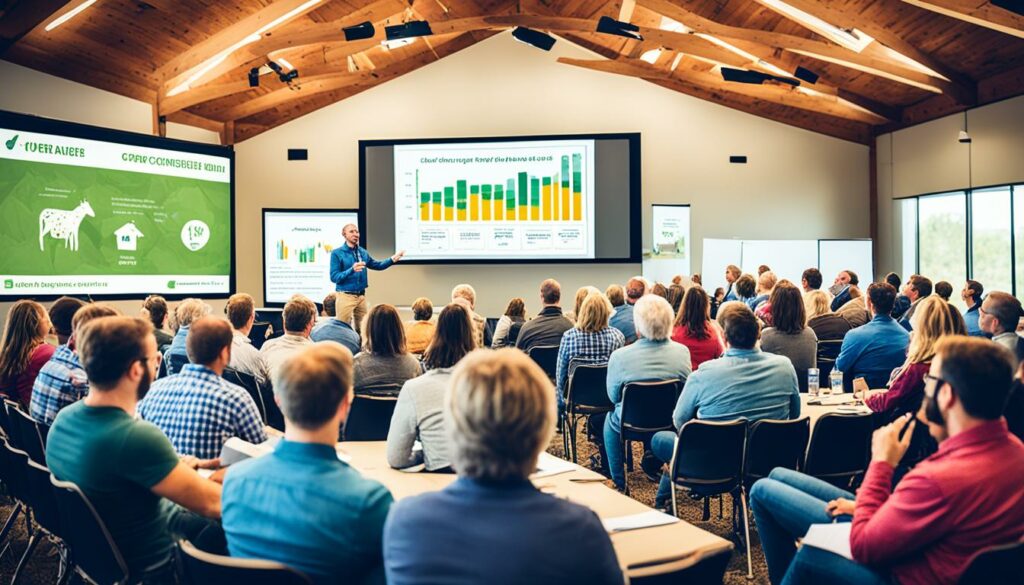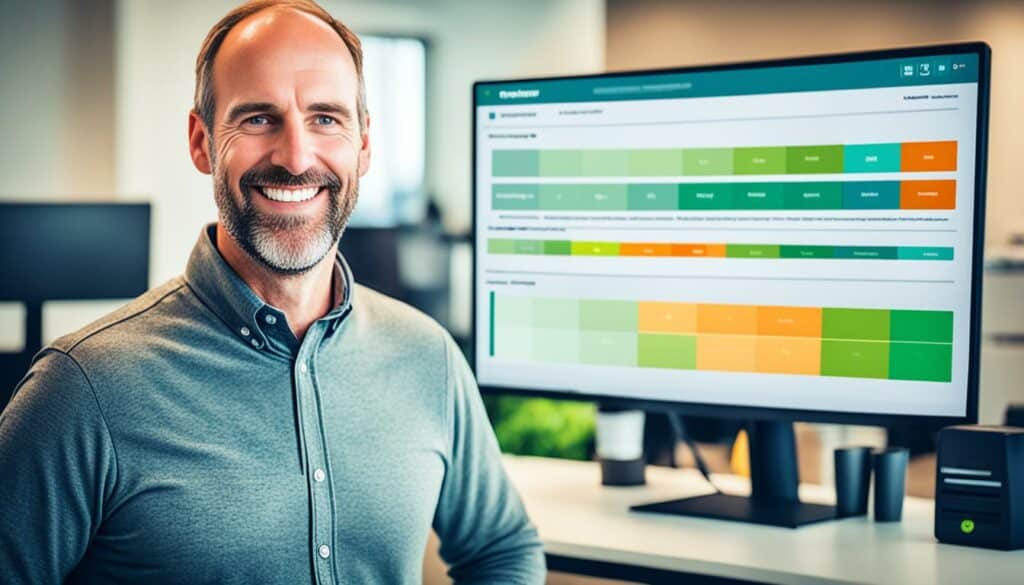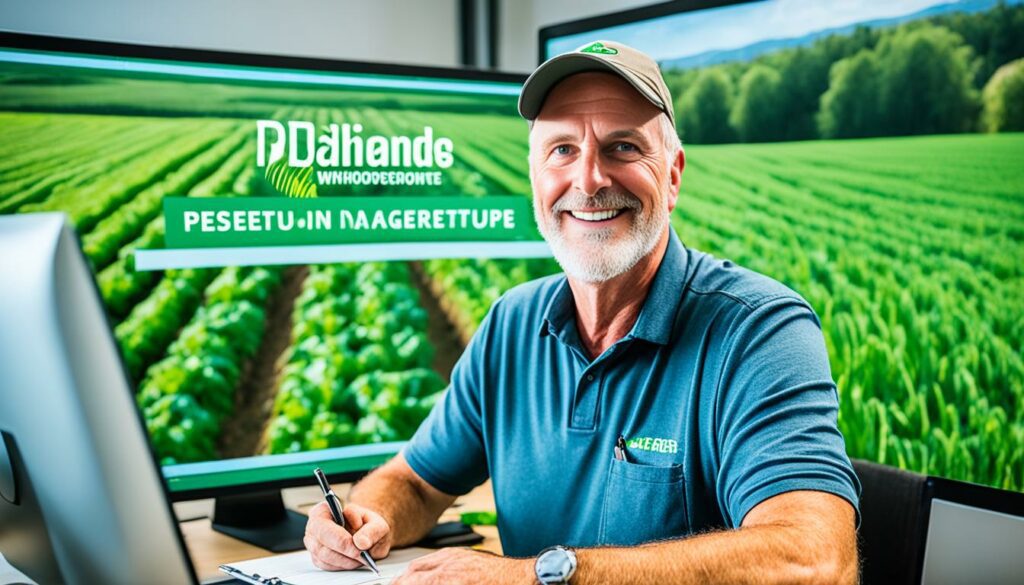Menu

Did you know that farmers find webinars very useful for learning? They’re keen on new agricultural research and products. The agri sector is moving to digital methods, making webinars a key way to reach customers. This change is helping to link customers with different brands. It also creates a place for everyone to share ideas.
Webinars are great for companies wanting to connect with rural areas. They’re a smart way to show what a business knows. This can help build trust in those who live in the countryside. For example, the March 2024 online workshop, held via Google Meet, is a big hit because it’s free to join.
Webinars use online videos to share knowledge and get immediate feedback. They bring in more people than traditional ways of marketing. For example, in September 2020, a webinar shared photography lighting tips. And in February 2020, a session discussed legal issues for North Carolina’s farming businesses. These focused discussions hook the audience well.
Webinars are now key in engaging customers, especially in farming. They let people talk in real-time, creating important discussions. This is very important for those living in rural areas.
The internet has brought webinars to the heart of customer interaction. They allow for broad but personal communication. Businesses can now easily reach people across large areas. This helps in creating a strong community feel.
Webinars bring many good things for engaging with customers. They act as direct communication spaces. This boosts their popularity among farmers. Webinars go beyond sharing facts. They make people interact and form personal connections. This is ideal for forming trust and loyalty with the audience.
“Webinars foster an invaluable space for dialogue and interaction, crucial for nurturing trust and connections within the agricultural sector.”
Video content is great at keeping people interested. It’s a key way to boost countryside webinar participation. With interesting visuals and ways for the audience to join in, more people get involved in agriculture events.

Video in webinars makes learning interesting and fun. It’s perfect for showing how complex agricultural processes work or explaining new technologies. A good example is when the NIFA’s Center for International Programs used video in a webinar on May 22, 2019. They talked about global opportunities in farming. Using video made their message clear and fascinating.
But it’s not just about pretty pictures. Video webinars also allow people to talk back. This back-and-forth makes learning interactive. Audience members can take part in polls, ask questions, and share thoughts right there. This makes countryside webinars more engaging. An example is when the USDA’s Foreign Agricultural Service and the National Institute of Food and Agriculture held a presentation on April 13, 2018. They used interactive videos to connect better with their audience. This boosted the level of interest in the farming conference.
And then there are special tools that help in interacting during webinars. For instance, Rikin Gandhi showed a great example on March 8, 2017. He used Digital Green’s webinar tool in farming events. The way he let people exchange ideas made the webinar both memorable and informative.
Online workshops and rural virtual events in agriculture can boost engagement. These events let people talk about important topics. They also help in sharing valuable thoughts.
In webinars, chat spaces and breakout rooms offer double benefits. They make it easy for people to join discussions. They also help in networking and share different points of view for a better learning experience.
Through interactive rural events, businesses can change how customers see them. By talking openly and working together, trust grows. This makes the brand seem more knowledgeable and trustworthy within the farming community.
| Webinar | Date | Time | Cost |
|---|---|---|---|
| Norris Square Community Profile | April 17 | Noon – 1:15 p.m. | $50 for series, $95 AICP/PDH |
Well-planned online workshops and virtual events can really make people in farming engage. They improve how people see the brand. This can lead to stronger support for the brand.
Peer-to-peer networking is key to growing professionally in agriculture through webinars. Farmers connect with each other during virtual events and learn from one another. This interaction builds a strong community and helps the industry grow together.
The Quivira Coalition’s Mentor Training Series is a great example. It has seven sessions from October 2020 to April 2021, covering important topics for farming success. These webinars provide a rich learning experience for those who attend.

The sessions take place on Zoom at 12 pm Mountain Time. They are designed to encourage active participation. Examples include talks on communication by Polly Shyka and Laura Paine’s insights on adult learning in agriculture.
Interesting webinars use tools like breakout rooms and chat spaces. This lets the audience engage deeply, which can be harder in person. Abby Sadauckas and Leslie Forstadt, for example, discussed new farmer types and skill development.
Webinars also tackle important legal and operational farm issues. Beth O’Neal’s webinar on Ag employment law gave practical farming advice. This kind of information is very beneficial for farmers.
Below is a table showing some important webinars and what they focused on. It shows the variety of topics covered and speakers, enhancing the learning experience:
| Webinar Date | Presenter | Topic |
|---|---|---|
| 10.15.19 | Polly Shyka | Communication in Farm Apprenticeships |
| 6.19.18 | Laura Paine | Working with Adult Learners |
| 5.11.18 | Brian Wheat | Transition from Incubator to Apprenticeship Model |
| 5.31.18 | Beth O’Neal | Employment Law for the Farm |
| 4.10.18 | Abby Sadauckas and Leslie Forstadt | New Farmer Typologies and Skill Acquisition |
Attending farming seminars and webinars does more than educate. It helps build lasting relationships and support networks in agriculture. This process helps professionals grow and ensures a strong, connected farming community.
It’s vital to make webinars rich and interesting, especially in farming. The goal is to engage and teach without overloading. Doing this boosts how well webinars are received. It also helps the community feel closer and shows how crucial farming education is.
Jon Schumacher tells us to focus on key ideas, with 80% being big picture stuff and only 20% details. This makes sure the audience doesn’t get too much to handle. Schumacher knows his stuff, working with many clients in various fields and teaching many students. His method makes webinars open to everyone, driving more interest and joining in.
Giving solid advice showcases a brand and makes people’s time worthwhile. The big hit Webinar Mastery Summit, led by Jon Schumacher, proves this. It brought in over 13,000 viewers globally. Keeping things simple and to the point makes farm webinars a powerful tool for learning.
Creating content that people find useful builds trust. It’s crucial since most folks check out a business before buying, and they prefer trusted brands. This trust can boost sales and lead to more profits through smart selling strategies.
In the end, top-notch content and know-how can really make a difference in webinars. They not only draw people in but also keep them coming back, creating a community that’s both loyal and well-informed.
Webinars are a great way to show you’re an expert, especially in farming. I talk about going to farm conferences and keep the chat interesting. This helps people trust what my business says about farming because we know our stuff well.
Talking about the latest farming trends in webinars helps get people interested. We share what we think about big farming issues. This way, people see our company as a go-to for good info and ideas. It makes us more trustworthy.
By discussing in-depth farming topics, we show we know a lot. This makes people see us as leaders in the farming field. Doing regular webinars helps us become a top source for farming knowledge.

To make farm webinars popular, plan well and use fun, interactive parts. Talking about farming topics that matter a lot makes people more interested. For example, in 2023, the Farm to School webinars talked about helping Indigenous food, smart climate practices, and how to market better. This brought in a lot of interest and people joined in.
It’s key to get people to join in. Things like live polls, answering questions, and chatting help keep them interested. A great example is Future Harvest’s 2023 events that more than 600 joined. They had things like hands-on events and times for people to meet up. These made learning more enjoyable.
It’s important to make the webinars fit what people in rural areas care about. For instance, in 2021, a webinar talked about gardening safely during the health crisis, showing the real-life issues. The 2020 Future Harvest’s webinars talked about big farming problems during the health crisis and helped 130 farmers solve their problems better.
Take time to plan and make your online farming events exciting and useful. If you meet the farmers’ needs and get them to share, webinars can be great for learning and making connections. By doing this, companies can make the most of webinars and offer a good, learning time to everyone.
| Year | Events | Participants | Key Features |
|---|---|---|---|
| 2023 | 26 on-farm educational and networking events | Over 600 | Interactive elements like hands-on days |
| 2020 | 20+ webinars and on-farm programmes | More than 950 | Topics addressing COVID challenges |
| 2023 | Farm to School grantee webinars | N/A | Focus on Indigenous and climate smart practices |

Adding polls and surveys to farm webinars is a smart way to make them more engaging and educational. These tools help me figure out what the viewers like and need. So, I can adjust the content to better match their interests.
When I use polls in webinars, I learn about the viewers’ likes and what they expect. I ask them about the produce they prefer, what crops they need, and how much they consume. This gives me a glimpse of what they’re interested in. And with this data, I can make the webinars better for them. Using their feedback, I can keep the content up to date and interesting.
With surveys and polls, the audience isn’t just watching; they’re also part of the discussion. This gets more people involved and makes them feel important. Their opinions shape the conversation, making the webinar more personal. This way, apart from being engaging, the session also builds strong customer connections. It sets the stage for lasting interest and loyalty.
Social media like Facebook and Twitter are also great for feedback. They allow for a closer bond with the audience. I can learn what they like through these platforms. This information helps me improve the webinars for them.
Q&A sessions are key in webinars. They create a direct connection between the speaker and the viewers. This way, the audience gets their questions answered and concerns addressed. It makes the conversation truly responsive.
Most webinars mostly show Powerpoint slides. The person running it usually talks a lot, taking up at least 80% of the time. For countryside webinars to be engaging, though, it’s better if the speaker talks only 10-20% of the time. This shift lets Q&A sessions and other interactive parts happen more. As a result, people are eager to join in, making the whole experience better and more engaging for everyone.
Having clear goals is important for a better webinar. By adding Q&A parts at the right moments, you can stop the talk from getting boring. This keeps the audience’s attention sharp. A good tip is to have a Q&A every 15-20 minutes.
It’s suggested that groups work together for 10-15 minutes. Then, they should get 2-4 minutes to present what they’ve discussed. Tools like Zoom’s breakout rooms help a lot with this. They allow for small group chats. This can make the Q&A part more interesting and valuable for everyone.
When going digital, keeping groups to a maximum of 5 ensures better communication. Games like Jigsaw Activities can make things fun. They encourage everyone to take part. These methods are great for keeping countryside webinars lively. They also make people more willing to join in and remember the experience.
Getting people excited before your webinar day is key to getting more people to come. How you get the word out can make a big difference. It helps make sure more people show up and take part actively.
Kicking off interest before the event is very important. You should give a sneak peek at what’s to come, talk about current issues facing farms, or ask people what they think. Doing this makes attending your webinar something they look forward to.
Social media is your best friend for drawing in more viewers. Use Facebook, Twitter, and other sites to get the word out, and keep folks interested. Using posts, videos, and sharing news can help spread the word faster and in a more fun way.

By using social media well, you make your webinar more visible. This also helps you build a connection with potential viewers. Having a promotion plan that speaks to farmers can really help your webinar succeed.
| Promotion Activity | Recommended Timing | Expected Outcome |
|---|---|---|
| Initial Email Blast | 30-40 Days Prior | Raise Awareness |
| Social Media Teasers | 3 Weeks Prior | Create Buzz |
| Targeted Ad Campaigns | 2 Weeks Prior | Drive Registrations |
| Rminders (1 Week, 1 Day, 1 Hour) | Ongoing Up To Event | Maximize Attendance |
Sharing webinar recordings is a great way to keep your content alive and reach more people. It’s especially useful for folks in the countryside. They can catch up on missed events whenever they like. This not only helps those who couldn’t make it but also lets others dive deeper into the topics.
Adding these recordings to your marketing plan makes your content last longer. It keeps people interested for future events. So, it’s a win for everyone. Your audience keeps learning, and you build a stronger bond with them.
We’ve seen how big an impact webinars, like the one on June 13, 2019, about volunteer opportunities, can have. For example, the May 22, 2019, webinar on engaging globally with AFRI’s RFAs was very popular. Sharing recordings from these talks, like those on food security or improving extension work through tech, helps more people learn.
Offering recordings of key rural events is vital, like the use of local foods in education (August 2018). And sessions that boost family involvement in early education (April 2018) are both educational and engaging. This method broadens your impact, creating a more informed and linked farming community.
Add extra resources to agriculture online workshops to make learning better. This way, attendees can learn more after the webinar ends. They can explore topics further and use what they’ve learnt in real life.
Downloadable content, like whitepapers and case studies, lets learning continue after the session. These are great for referring back to what was taught. For example, after a SNAP 101: Best Practices for EBT & Nutrition Incentives webinar, useful guidebooks are available. They summarise the main points and show best practices.

Give extra resources to keep people more involved during online workshops. This could include in-depth graphics, full reports, or special online tools. For instance, the National Farmers Market Week Toolkit Walkthrough Webinar might provide a special toolkit. It helps people use the strategies talked about in the webinar.
This shows a dedication to educating and supporting the farming community. It tells attendees that the organisers care about their learning. This can lead to more people joining farming seminars and being happier with the webinars.
Analysing webinar data helps us make better webinars. It is key to creating content that people enjoy. By looking at important numbers, we can see what works and what doesn’t.
It’s important to look at things like how many people show up, who joins in, and the feedback they give. This is similar to the Farm Income and Wealth Statistics for the US. They help shape how we teach about farming with their detailed reports.
When looking at data, focus on:
Using what we learn makes our next webinars better. Take the Beginning Farmer Webinar Series, for instance. It became more successful over time. They used feedback to adjust their topics and methods, which was right on target for their audience.
Learning and adapting helps not just now, but later too. Here’s why:
With careful tracking and improving, our efforts in rural education aim to stay important and loved by attendees.
Farm webinars are key for engaging customers in farming. From 2012 to 2016, 63 webinars drew 607 people. Of those, 105 shared feedback.
These webinars reached across 47 Michigan counties. More than half were current farmers. Yet, 21% dreamt of farming in the future. This hints at their strong interest.
Webinars create an interactive space. They help presenters share insights. At the 2023 Free Virtual Workshop, topics like agricultural science and 3D learning were discussed.
Teachers spent 1 to 2 hours gaining new ideas. They learned about eco-systems and genetics from experts. This helped them teach farming in exciting ways.
Looking at feedback after webinars helps improve. Beginning Farmer Series participants shared positive outcomes. They increased their knowledge and started new farms. This suggests webinars help farming grow.
Interactive webinars with videos and discussions work well. They educate and unite the farming community. This makes each webinar important in building connections and boosting industry engagement.
Farm webinars use lively content, strong visuals, and real-time talk to connect with people. This mix of expert views, live feedback through polls, and questions makes everyone more involved. It also helps grow strong bonds in the farming world.
Online workshops in farming are great because they’re easy to join from home. They let people discuss and learn on the spot, talking about things that matter to those in the countryside.
Video brings the farm to you, which can really grab your focus. It means you can talk live with others and share ideas easily. This makes the whole experience more personal and helps you remember it better.
Chat areas and separate discussion rooms help dig into important topics together. They can change how you see things and help strengthen the farming community feeling.
Webinars are a place to connect, share ideas, and make deals. They boost teamwork and shared learning, making you feel part of a bigger network beyond the webinar.
Good, insightful content makes you a go-to person in your field. It teaches and grabs people’s attention, showing your brand as a leader in farming.
Show what you know in a clear, clever way to win trust and respect. This makes people believe in your ideas and trust your brand more.
Planning well and using live polls, discussions, and relevant topics are essential to keep people involved. Making the content fit what your audience needs and asking them to join in can make everyone feel part of a community and more interested.
By running polls and surveys, you get immediate feedback on what the audience likes. This makes people more interested, feeling like their views are heard and matters. It improves their time during the webinar.
Q&A lets attendees and experts talk directly. It clears things up and addresses what the audience wants to know, making people feel more involved.
Talking with potential guests on social media before the event creates excitement. Using ads, videos, and hot topics can get more people to join in and be active during the webinar.
Sharing videos lets others watch them later, which extends your content’s reach. It’s a way for people to catch up, learn more, and stay engaged over time.
Adding extra materials, like guides and downloads, deepens what the webinar shared. It offers more insight and commitment to supporting the farming community fully through education.
Looking at stats from past webinars helps make the next ones better. It shows what works and what to change for the future, making each event more relevant and meaningful for the audience.